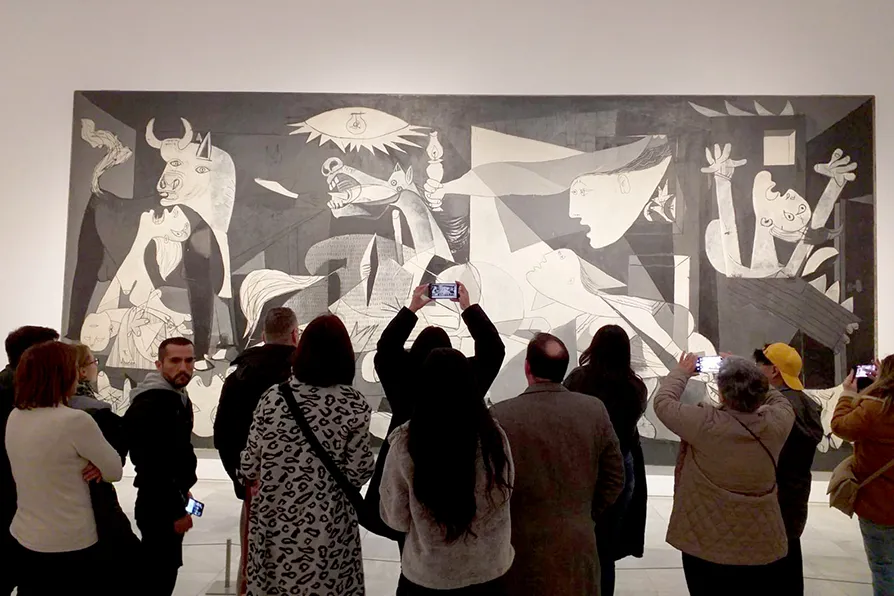JOE GILL speaks to the Palestinian students in Gaza whose testimony is collected in a remarkable anthology
Reading Picasso’s Guernica like a comic strip offers a new way to understand the story it is telling, posits HARRIET EARLE

 HYPNOTIC: People and Guernica in 2024 at the Museum Of Queen Sofa, Madrid. Pic: Ertly/CC
HYPNOTIC: People and Guernica in 2024 at the Museum Of Queen Sofa, Madrid. Pic: Ertly/CC
GUERNICA by Pablo Picasso is one of the most famous artworks of the 20th century. The painting is huge and violent, and when it was first displayed in 1937 it was considered absolutely groundbreaking.
In 1937, at the height of the Spanish civil war, the town of Guernica in the Basque Country was destroyed in a three-hour bombing raid that left it in burning ruins. Hearing the news in Paris, Picasso was immediately stirred to create the painting as a cry of pain and protest and to demand international attention.
The painting took him just 35 days. It appeared first at the World’s Fair in Paris where it received a negative reception. Patrons were “repelled by it,” according to the architect Le Corbusier. It is easy to see why.
Guernica is chaotic. Picasso’s anger and distress can be felt in every stroke. Too large to easily see all at once, it demands we stand back, that we take our time to consider what we are seeing. An enormous horse, its abdomen gaping from a large wound, fills the centre, next to a deformed bull. At the left edge, a woman cradles her dead child, while at the right a woman burns. At the bottom, a man lies dead, broken sword in hand. Above, two witnesses hover, one bearing a lamp.
I believe that Guernica is not just a painting: it is also a comic. This might sound like a strange claim. Comics are often seen as a low art form – short, funny stories for children, told in newspapers and cheaply printed magazines. But that’s only a tiny part of what comics really are.
The art-form is one of the oldest ways of telling stories and, at its root, can be used for any narrative told in images. Words often accompany these images, but not always. Experts are constantly debating how to define “comics” and no firm answer has been found. But for me, “comics” means a method of telling stories in images, and, conversely, reading stories in images.
Guernica is a chaotic scene: there are a lot of figures moving. It looks as if the painting is contained within one room, with several windows and doors open. There are two clearly drawn windows, at least one open door and a corner. In the centre of the painting, there is a tiled roof – are we inside or outside?
The ambiguity of our position reflects the chaos of the rest of the painting – and the chaos of the bombing itself. We can split the painting into three vertical sections. Using comics terminology, the left half is one panel and then the right half is divided into two panels.
We might read the painting from left to right: the figures in the middle reacting to the left, the figures on the right reacting to the middle. But Guernica does not give us the comfort of sequence. Everyone is moving and screaming, dying and witnessing, all at once. The action is not happening sequentially, but at the same time.
Most paintings have a single focal point that draws the eye before allowing the viewer to take in the rest of the painting. The lack of focal point and chaos of multiple panels in Guernica creates an image that is both distressing to view and representative of the chaos of the event itself.
If we can recognise the comic-esque aspects of Guernica, we can start to see the many ways the comic form infiltrates lots of aspects of media. As a researcher, I am concerned with the way that the (largely woman-centric) history of needlework intersects with comics and storytelling. Comics are not just about superheroes or written for children: the form is open to all kinds of readers.
Comics can be used for teaching children to read and learn about storytelling; teaching English as a foreign language and for lower levels of literacy. Comic stories are, in their visual nature, designed to work on many levels.
Viewing Picasso’s astounding work of art as a comic does not diminish its power: it gives us a new framework to read it and to understand the story it is telling. The story is one of violence, trauma, and destruction – with the tiny hope of the glowing lamp.
Reading Guernica as a comic positions the painting not as a lofty work of fine art, but as a public narrative of violence – something I have no doubt Picasso himself would applaud.
Harriet Earle is senior lecturer in English and Creative Writing, Sheffield Hallam University.
This article is republished from The Conversation under a Creative Commons license.
Please DO NOT REMOVE. —><img src=”https://counter.theconversation.com/content/231653/count.gif?distributor=republish-lightbox-basic” alt=”The Conversation” width=”1” height=”1” style=”border: none !important; box-shadow: none !important; margin: 0 !important; max-height: 1px !important; max-width: 1px !important; min-height: 1px !important; min-width: 1px !important; opacity: 0 !important; outline: none !important; padding: 0 !important” referrerpolicy=”no-referrer-when-downgrade” /><!— End of code.

BLANE SAVAGE recommends the display of nine previously unseen works by the Glaswegian artist, novelist and playwright

Heart Lamp by the Indian writer Banu Mushtaq and winner of the 2025 International Booker prize is a powerful collection of stories inspired by the real suffering of women, writes HELEN VASSALLO












